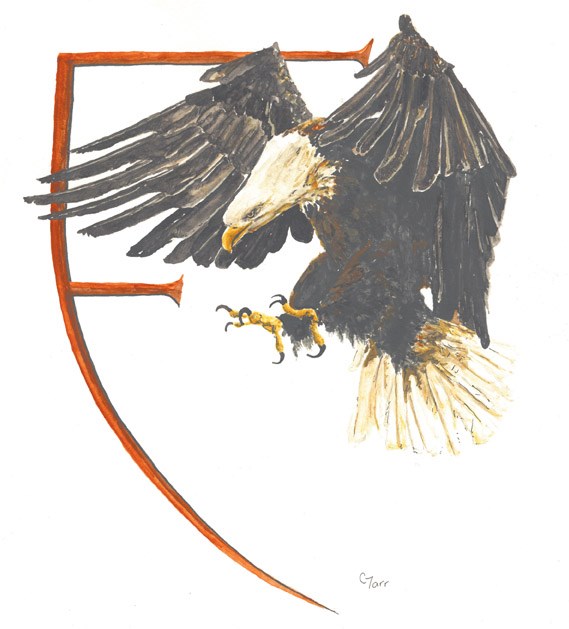When you get 26 artists together, you inevitably get all kinds of styles and personalities. For the Citizen's special art event called The Alphabet Project, the collection included specialists in watercolours, acrylics, oils, mixed-media, sketching, and many more. Crystalynn Tarr was the specialist in dirty pictures.
Tarr was the recipient of the letter E in the random draw that paired the artists with the letters they would create. "I was so excited to get E of all letters, because E is for earth and earth is what I paint with," she said.
Her dirty pictures are made of soil, rock, dust and other terrestrial aggregate. She grinds it into powder and using an old recipe (ancient Egyptian - that old) she crafts the colours that she then dips her brushes into for her captivating paintings.
Her usual paintings depict landscapes and wildlife, with a particular interest in birds. E is also for eagle, and her esteem for the Alphabet Project was so high that the power of the eagle is the impression she settled on for her letter. Likewise, this was a chance for a painting to represent the earth itself and how the medium and the subject were so well connected.
"I thought of ways to combine the shape of the letter in combination with what the eagle was doing, like landing on branches of a tree that took the E shape," she said. "But the more I thought about it, the representation looked better when it was a strong letter on its own."
She spent a significant length of time working on the font that she would eventually use for her E. Tarr said she liked the final image because "the E was flowy but also solid, with a kind of Gothic look to it. I liked it. I didn't do tonnes of other Es in advance, a few though, and this is the one that seemed to fit best, seemed to be the strongest."
Flip through the below slideshow to view the Alphabet Project art and a link to each artist story:
The other thing in the painting, apart from the letter, was the eagle itself. She did preliminary sketches to attempt different poses the eagle might be in.
"This one finally seemed like the statement I wanted to make, like the bird still in flight was indicating something still going on, that there was some strong action happening, it was open ended and up to your interpretation about what the eagle is actually doing or feeling. It was like catching the eagle mid-sentence."
The eagle symbolically depicts the power of nature in a scene on the canvas. The soil and stone that created the paint itself is the literal power of nature splashed onto the canvas. In that sense, Tarr's E painting is telling a story about humanity's potential to work harmoniously with the natural world - that world being a thing of wonder and a tool.
Most artists have to think about how they shall choose colours to bring forth the image they are painting. Tarr has to think excessively about how to create the colours that she will then have to make choices with. Although building paint from the pigment of stone and dirt means her images will sustain their colour for eons (literally) longer than manufactured paint or plant-based pigments, her palette is quite limited.
"Blue shades are harder to find, so you have to rely on rocks and even semi-precious stones to crush down. I tend to use more greys as substitutes for the blue colours," she said.
An up-close look at her eagle shows two different tones of black, and one of those came from a first-time experience for her, an extra length she went to just for this project.
"My dad lives in Elkford and he got me some coal from that area," she said. "I didn't realize how hard coal is so I had to borrow someone's ball-mill for crushing it into dust because I couldn't break anything more than chips off the rock by using my hammers. A ball-mill is now on my wish list."
On the back of each artpiece, Tarr does is a bibliography of sorts. She lists the colours and where on earth she obtained that colour. In the case of the E, the source material came from Elkford, the road to Loon Lake, the Southridge underpass in Prince George, the Nechako River, Tabor Mountain, a rock outcrap near Purden, Batinuni Lake, Kinbasket Lake and the Okanagan Valley.
She is always on the hunt for rocks and soils that catch her attention for their colour, and she keeps a careful account of those places.
Prince George is a place she's kept a careful account of in her heart. Shortly after completing her letter E, she and her family moved away to the small mining community of Nordegg, Alberta. It represents a switch from the western toes of the Rocky Mountains to the eastern foothills of the jagged range. It's coal country. She is already missing the art community and human connections of Prince George - she was the Community Arts Council's most recent artist-in-resident and a favourite name at cultural events like Art Battle, the 6x6 Art Auction, her recent solo show at the Two Rivers Gallery, etc. - but small towns have their charms as well, and one of them for her is a new trove of colours to mine from the E-E-Earth.




